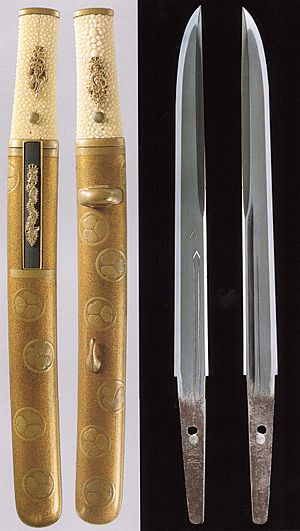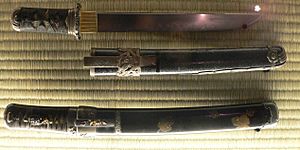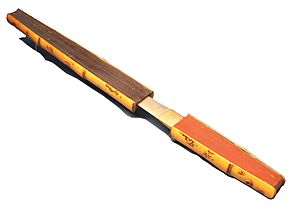Tanto facts for kids
The Tanto is a special kind of Japanese short sword or dagger. It was used by samurai in ancient Japan. Think of it as a smaller, very sharp blade that was easy to carry and use in close-up fights.
Contents
What is a Tanto?
A Tanto was usually about 11.93 inches (30 centimeters) long in total. The blade itself was often between 5 to 12 inches (12.5 to 30 centimeters). If a blade was a bit longer, like 13 or 14 inches, it was sometimes called a "ko-wakizashi" or "small short sword." Some Tantō were made bigger than usual, and these were called O-tanto or Sunobi tanto.
The Tanto had a single sharp edge and a curved shape. It was designed to be very effective in close fighting. Samurai often carried it as a hidden weapon.
The History of the Tanto
The Tanto first appeared a very long time ago, during the Heian Period (from 795 to 1192 A.D.). It became an important weapon during the Kamakura Period (1192-1333 A.D.). Back then, a Tanto was not just a weapon; it was also a beautiful piece of art. Many were decorated with fancy styles.
Later, during the Nambokucho period (1336-1392 A.D.), Tantō blades started to get longer, sometimes over 15.75 inches (37 centimeters). They also became thinner and wider, which made them even more dangerous. Different styles and shapes developed over time. By the Muromachi Period (1336–1573 A.D.), the Tanto became narrow-bladed again.
How Tantō Were Made
Over time, the quality of Tantō blades got much better. This was when professional smiths (people who work with metal) became very skilled. There were several famous styles of making Tantō. Some of the best-known smiths were Sukesada and Norimitsu, Kanemoto and Kanesada, and Muramasa and Masashige.
When the Edo period began (1603-1867 A.D.), Japan had a time of peace. Fewer Tantō were made, but the ones that were created were still of very good quality. The special pattern on the blade's edge, called the hamon, became more wavy and artistic.
Different Kinds of Tantō
Many Tantō were made over 700 to 800 years. Some were for everyday people, and others were made especially for samurai. One way to tell them apart was by their hand guard:
- Tantō with a guard called a tsuba.
- Tantō with an aikuchi style guard.
- Tantō with a hamadashi style guard.
The aikuchi and hamadashi styles were very popular. This was because their small guards made them easier to hide and carry. Since the Tanto wasn't often used on big battlefields, a large guard wasn't always needed.
Tantō also had different blade shapes:
- Hira-zukuri: This style had a flat, narrow, and thick blade. It was good for slashing and piercing.
- Shobu-zukuri: This one had a ridge line and a groove, sometimes called a "blood groove."
- Moroha: A very rare Tanto that had two sharp edges.
- Kissaki-moroha-zukuri: This style had a very long and sharp point.
- Kaikan: These were short Tantō with small guards. Women often carried them for self-defense.
How the Tanto Was Used
When a Tanto was used in battle, its main purpose was to get through an opponent's armor when they were very close. The best Tantō for this had a long, narrow blade and a thick back (spine). The user would aim the point under or through the enemy's armor.
Samurai usually carried the Tanto in a wide cloth belt called an obi. They would wear it with the sharp edge pointing up and the handle turned to the right. In a samurai's home, the Tanto was often kept alongside the wakizashi (another short sword). Samurai women were taught how to use the Tanto to defend themselves if they ever needed to.
Other pages




